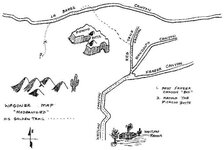Hal Croves
Silver Member
- Sep 25, 2010
- 2,659
- 2,697
In this thread I hope to collectively review the various published solutions to the stone charts. Please feel free to post your comments and or observations. I will begin with Crawford's Trail Map, which I must say is an amazing effort and one that should not be ignored. My initial concern with the Crawford map is the meandering, difficult route it requires to reach the end of the trail... which begins in Queen Valley(!!). A much shorter and perhaps less arduous trail would begin in Gold Canyon.
Red = Trail stone
Green = Access Road
The Crawford Trail Map Reproduced in Google Earth
Crawford's End of Trail (Topo) - Note: Cave
Crawford's Search Area - Note: Circular Anomaly
Anomaly In Crawford's Search Area - Size: 30' x 30'
Red = Trail stone
Green = Access Road
The Crawford Trail Map Reproduced in Google Earth
Crawford's End of Trail (Topo) - Note: Cave
Crawford's Search Area - Note: Circular Anomaly
Anomaly In Crawford's Search Area - Size: 30' x 30'




 Some may recall that name from another story.
Some may recall that name from another story. 

